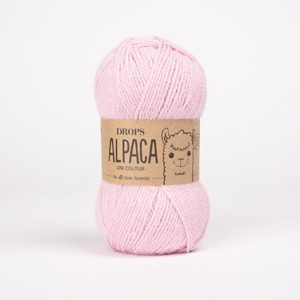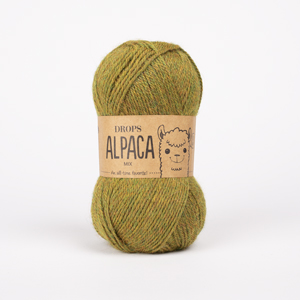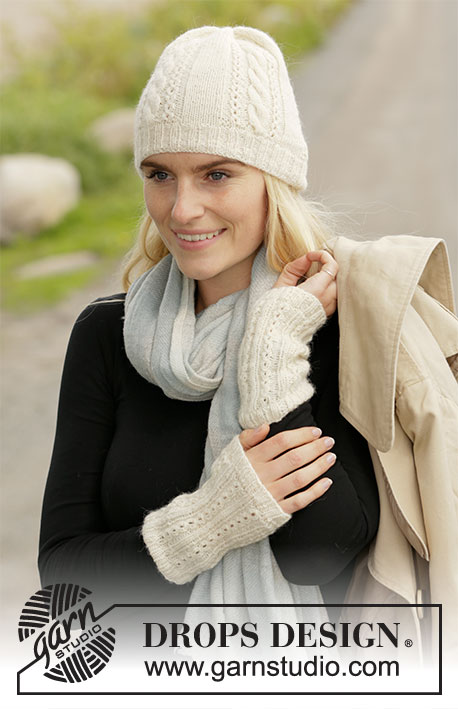Comments / Questions (7)
![]() Julie wrote:
Julie wrote:
Spørsmål om halsen: Når man strikker to rettmasker etter A.1, blir det 4 riller på den ene siden. Skal man ikke strikke A.1 ut pinnen slik at det blir annenhver rett og riller?
19.12.2022 - 00:03DROPS Design answered:
Hei Julie, Hvis du strikker størrelse S/M, har du 64 masker. Du strikker 1 maske i rille, A.1 (som er 4 masker) til du har 3 masker igjen (x15), 2 rett og 1 maske i rille. Når du strikker tilbake, blir de 2 rettmaskene strikket vrang. Så du strikker vrangbord med 1 maske rille på hver side. Det blir det samme i den større størrelsen, men A.1 x 16. God fornøyelse!
19.12.2022 - 06:57
![]() Marika wrote:
Marika wrote:
Bonjour équipe Drops, Votre réponse est très claire, mille mercis. Bien cordialement.
27.09.2021 - 18:44
![]() Marika wrote:
Marika wrote:
DROPS design: Modèle z-879 bonjour, pour le bonnet, il est indiqué : "Tricoter maintenant 4 fois A.2 " or, A.2 représente 30 rangs ? Je ne comprends pas quels sont les rangs à tricoter 4 fois, je vous remercie de votre réponse, bien cordialement. N.B. merci à vos équipes pour tout ce travail d'explications qui nous permet de réaliser de jolis ouvrages, je suis fan de votre site et de la laine DROPS depuis de nombreuses années.
26.09.2021 - 21:53DROPS Design answered:
Bonjour Marika, vous devez tricoter 4 fois A.2 en largeur, autrement dit vous répétez 4 fois le diagramme sur toutes les mailles de l'aiguille, si vous avez 112 mailles, vous répétez 4 fois ces 28 mailles (= 4x28=112 m) et si vous avez 128 m, vous répétez 4 fois ces 32 mailles (= 4x32=128 m). Quand les diagrammes sont terminés, il vous reste 4 fois (4 mailles) = 16 mailles au total. Est-ce plus clair ainsi? N'hésitez pas à nous le dire si ce n'est pas le cas. Bonne continuation!
27.09.2021 - 08:41
![]() Tina wrote:
Tina wrote:
Hei, når det gjelder halsen. Skal selve halsen som strikkes rundt etter at man har strikket de to delene i struktur, strikkes som vrangbord, 2rette og 2 vrange og ikke struktur? hilsen Tina
09.12.2020 - 12:20DROPS Design answered:
Hej Tina, ja det stemmer, da strikker du vrangbord 2 ret, 2 vrang. God fornøjelse!
15.12.2020 - 14:46
![]() Susanne Krüger wrote:
Susanne Krüger wrote:
Hallo! bezieht sich die Maschenprobe von 24 Maschen glatt rechts auf 10 cm auf die Nadelstärke 3 oder 2,5 für die Mütze?
16.11.2020 - 09:42DROPS Design answered:
Liebe Frau Krüger, die Maschenprobe wird glatt rechts mit den grösseren Nadeln = Nr 3 für die Mütze gestrickt. Viel Spaß beim stricken!
16.11.2020 - 10:09
![]() Cecilia wrote:
Cecilia wrote:
Fortsättning angående halsvärmaren: 3. Man stickar sedan enligt mönstret (ej slätst), och mitt i instruktionen står med versaler "Kontrollera stickfastheten". Det tycks mig underligt då provet anger slätstickning och halsvärmaren stickas enligt angivet mönster. Jag vill förstås undvika att sticka färdigt en halsvärmare som visar sig helt fel i storlek.
03.02.2020 - 12:18DROPS Design answered:
Hej Cecilia, om du i ditt stickprov har 23 m på 10 cm i slätstickning, så vill du få rätt mått på halsvärmaren. Lycka till :)
11.02.2020 - 08:52
![]() Cecilia wrote:
Cecilia wrote:
Hej! Jag är förbryllad över halsvärmaren. 1. Det är instruktion för stickfastheten för mössan och halsvärmaren - är det avsiktligt eller ett skrivfel? 2. För stickfasthet står: 23m och 30 varv ska ge 10x10 cm. Under rubriken "STICKOR" står "rundsticka 3,5" medan det i senare instruktion står "Lägg upp 64-68 maskor på rundsticka 3". Ska man göra ett prov på sticka 3,5 och sedan börja sticka 3? ........ Jag skriver fråga 3. i nytt meddelande.
03.02.2020 - 12:15DROPS Design answered:
Hej Cecilia, nej sticknummer är ett skriv fel, men det stämmer att du på ditt stickprov skall få 23 m på 10 cm på halsen. Och 24 maskor (lite tätare) på 10 cm på mössan. Tack för info, vi skall få rättat till st 3,5.
10.02.2020 - 17:10
Purity#purityset |
|||||||||||||
 |
 |
||||||||||||
Knitted hat and neck warmer in DROPS Alpaca for men. Piece is knitted with texture.
DROPS 208-10 |
|||||||||||||
|
---------------------------------------------------------- EXPLANATION FOR THE PATTERN: ---------------------------------------------------------- GARTER STITCH (back and forth): Knit all rows. 1 ridge vertically = knit 2 rows. PATTERN: Hat: See diagram A.1 and A.2 - choose diagram for your size. Neck warmer: See diagram A.1. Diagrams show all rows in pattern seen from the right side. ---------------------------------------------------------- START THE PIECE HERE: ---------------------------------------------------------- HAT - SHORT OVERVIEW OF THE PIECE: Worked in the round on circular needle, bottom up. Switch to double pointed needle when decreasing at the top. HAT: Cast on 112-128 stitches on circular needle size 2.5 mm with Alpaca. Work rib (knit 2/purl 2) in the round for 10 cm. Switch to circular needle size 3 mm. Work pattern A.1 (= 4 stitches) on round. REMEMBER THE KNITTING TENSION! When piece measures 23-25 cm from cast-on edge - adjust so that next row worked is first row in A.1 (i.e. A row knitted over all stitches), work as follows: Knit 1, insert a marker thread here. This is now beginning of rounds. Now work A.2 (= 28-32 stitches) 4 times in total on round. When entire A.2 has been worked vertically, there are 16-16 stitches on round. Cut the yarn and pull it through the remaining stitches, tighten together and fasten. Hat measures approx. 32-35 cm. Fold rib at the bottom up so that fold is approx. 5 cm. Hat measures approx. 27-30 cm with approx. 5 cm fold at the bottom. ---------------------------------------------------------- NECK WARMER - SHORT SUMMARY OF PIECE: Work piece back and forth in 2 parts on circular needle. Then slip the two parts on to same circular needle and work in the round on circular needle. NECK: Cast on 64-68 stitches on circular needle size 3½ mm with Alpaca. Purl 1 row from wrong side, then work pattern as follows from right side: 1 edge stitch in GARTER STITCH - see explanation above, A.1 (= 4 stitches) until 3 stitches remain on needle, knit 2 and finish with 1 edge stitch in garter stitch. Continue back and forth like this. REMEMBER THE KNITTING TENSION! When piece measures 13-14 cm, adjust so that next row is from right side, put piece aside. Knit another part the same way. Now insert the 2 parts together on same circular needle = 128-136 stitches. Insert a marker thread in each side (i.e. in transition between the 2 parts put together). Begin round at one of the 2 marker threads and work as follows: ROUND 1: * Knit 2 together (= 1 stitch decreased), knit over knit and purl over purl until 2 stitches remain before next marker thread, slip 1 stitch knitwise, knit 1, pass the slipped stitch over (= 1 stitch decreased) *, work from *-* 1 more time on round = 124-132 stitches. ROUND 2: * Knit 2 together (= 1 stitch decreased), knit over knit and purl over purl until 2 stitches remain before next marker thread, slip 1 stitch knitwise, knit 1, pass the slipped stitch over (= 1 stitch decreased) *, work from *-* 1 more time on round = 120-128 stitches. Then continue in the round with knit over knit and purl over purl. When piece measures 13-14 cm from where the 2 parts were put together on needle (= 26-28 cm in total), cast off with knit over knit and purl over purl. Cut and fasten the yarn. |
|||||||||||||
Diagram explanations |
|||||||||||||
|
|||||||||||||

|
|||||||||||||
Have you finished this pattern?Tag your pictures with #dropspattern #purityset or submit them to the #dropsfan gallery. Do you need help with this pattern?You'll find 18 tutorial videos, a Comments/Questions area and more by visiting the pattern on garnstudio.com. © 1982-2025 DROPS Design A/S. We reserve all rights. This document, including all its sub-sections, has copyrights. Read more about what you can do with our patterns at the bottom of each pattern on our site. |
|||||||||||||



























































Post a comment to pattern DROPS 208-10
We would love to hear what you have to say about this pattern!
If you want to leave a question, please make sure you select the correct category in the form below, to speed up the answering process. Required fields are marked *.